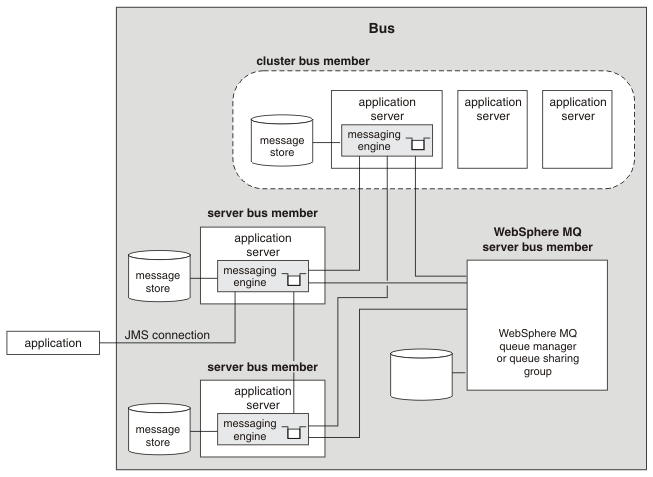WAS v8.5 > WebSphere applications > Service integration
Bus members
The members of a service integration bus can be application servers, server clusters, or WebSphere MQ servers. Bus members that are application servers or server clusters contain messaging engines, which are the application server components that provide asynchronous messaging services. Bus members that are WebSphere MQ servers provide a direct client connection between a service integration bus and queues on a WebSphere MQ queue manager.
To use a service integration bus, add at least one application server or server cluster as a bus member. We can also add bus members that are WebSphere MQ servers; service integration uses these bus members to write messages to, and read messages from, WebSphere MQ queues.
When you add an application server or a server cluster as a bus member, a messaging engine for that bus member is created automatically. If the bus member is an application server, it can have only one messaging engine. To host queue-type destinations, the messaging engine includes a message store where, if necessary, it can hold messages until consuming applications are ready to receive them, or preserve messages in case the messaging engine fails. If the bus member is a WebSphere MQ server, it does not have a messaging engine, but it lets you access WebSphere MQ queues directly from WebSphere MQ queue managers and (for WebSphere MQ for z/OS ) queue-sharing groups.
A WAS application does not have to be running on a service integration bus member to use its messaging services. If necessary, WAS automatically provides a connection to a suitable bus member.
Figure 1. Bus members

If required, we can remove members from a bus. However, this action deletes any messaging engines associated with a bus member, including knowledge of any messages held by the message store for those messaging engines. Therefore, you must plan this action carefully.
When a bus member is deleted, the data source associated with this bus member is not automatically deleted, in case you are also using the data source for some other purpose. This also applies to bus members created using the default data source: the data source is not automatically deleted and you must remove it manually. You need not remove the default data sources because they use a universal unique identifier (UUID) in the name of the Apache Derby database. However, you might choose to delete the data source to avoid wasting disk space.
Related
Configure the members of a bus
List the members of a bus
Remove a member from a bus
List the messaging engines defined for a server bus member
Administer message stores
Create the database, schema and user ID for a messaging engine
Configure a messaging engine to use a data store
Related information:
Bus members [Collection]
Bus members [Settings]